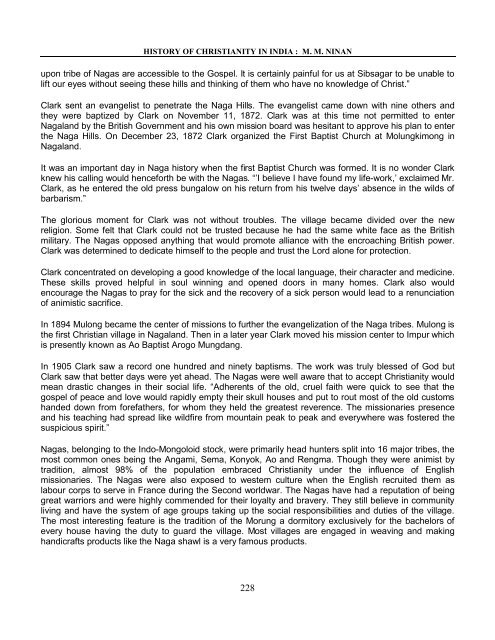Indian Christianity
Create successful ePaper yourself
Turn your PDF publications into a flip-book with our unique Google optimized e-Paper software.
HISTORY OF CHRISTIANITY IN INDIA : M. M. NINAN<br />
upon tribe of Nagas are accessible to the Gospel. It is certainly painful for us at Sibsagar to be unable to<br />
lift our eyes without seeing these hills and thinking of them who have no knowledge of Christ.”<br />
Clark sent an evangelist to penetrate the Naga Hills. The evangelist came down with nine others and<br />
they were baptized by Clark on November 11, 1872. Clark was at this time not permitted to enter<br />
Nagaland by the British Government and his own mission board was hesitant to approve his plan to enter<br />
the Naga Hills. On December 23, 1872 Clark organized the First Baptist Church at Molungkimong in<br />
Nagaland.<br />
It was an important day in Naga history when the first Baptist Church was formed. It is no wonder Clark<br />
knew his calling would henceforth be with the Nagas. “’I believe I have found my life-work,’ exclaimed Mr.<br />
Clark, as he entered the old press bungalow on his return from his twelve days’ absence in the wilds of<br />
barbarism.”<br />
The glorious moment for Clark was not without troubles. The village became divided over the new<br />
religion. Some felt that Clark could not be trusted because he had the same white face as the British<br />
military. The Nagas opposed anything that would promote alliance with the encroaching British power.<br />
Clark was determined to dedicate himself to the people and trust the Lord alone for protection.<br />
Clark concentrated on developing a good knowledge of the local language, their character and medicine.<br />
These skills proved helpful in soul winning and opened doors in many homes. Clark also would<br />
encourage the Nagas to pray for the sick and the recovery of a sick person would lead to a renunciation<br />
of animistic sacrifice.<br />
In 1894 Mulong became the center of missions to further the evangelization of the Naga tribes. Mulong is<br />
the first Christian village in Nagaland. Then in a later year Clark moved his mission center to Impur which<br />
is presently known as Ao Baptist Arogo Mungdang.<br />
In 1905 Clark saw a record one hundred and ninety baptisms. The work was truly blessed of God but<br />
Clark saw that better days were yet ahead. The Nagas were well aware that to accept <strong>Christianity</strong> would<br />
mean drastic changes in their social life. “Adherents of the old, cruel faith were quick to see that the<br />
gospel of peace and love would rapidly empty their skull houses and put to rout most of the old customs<br />
handed down from forefathers, for whom they held the greatest reverence. The missionaries presence<br />
and his teaching had spread like wildfire from mountain peak to peak and everywhere was fostered the<br />
suspicious spirit.”<br />
Nagas, belonging to the Indo-Mongoloid stock, were primarily head hunters split into 16 major tribes, the<br />
most common ones being the Angami, Sema, Konyok, Ao and Rengma. Though they were animist by<br />
tradition, almost 98% of the population embraced <strong>Christianity</strong> under the influence of English<br />
missionaries. The Nagas were also exposed to western culture when the English recruited them as<br />
labour corps to serve in France during the Second worldwar. The Nagas have had a reputation of being<br />
great warriors and were highly commended for their loyalty and bravery. They still believe in community<br />
living and have the system of age groups taking up the social responsibilities and duties of the village.<br />
The most interesting feature is the tradition of the Morung a dormitory exclusively for the bachelors of<br />
every house having the duty to guard the village. Most villages are engaged in weaving and making<br />
handicrafts products like the Naga shawl is a very famous products.<br />
228


















